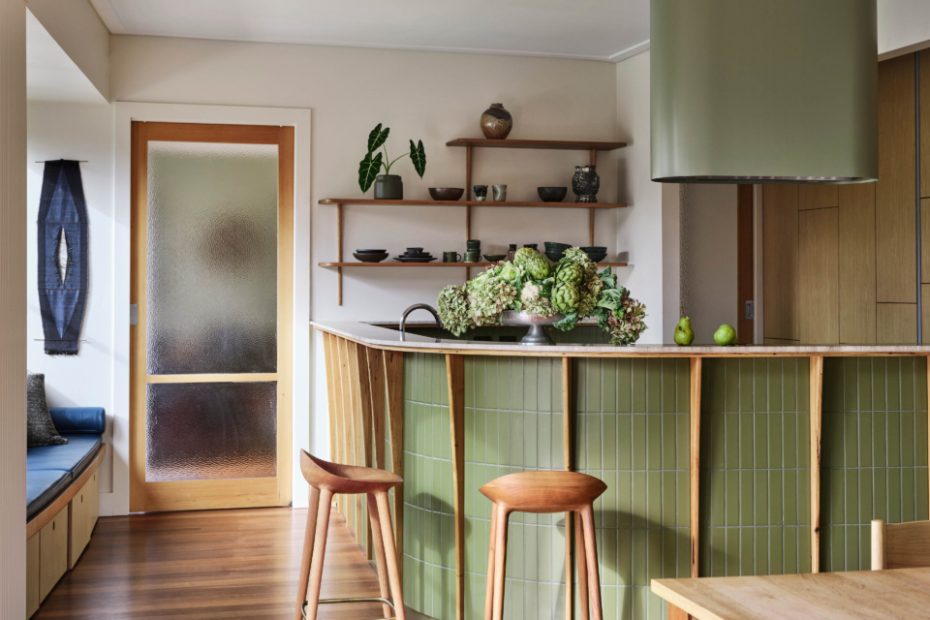A Japanese-Inspired Kitchen For A Uniquely Sustainable Home
Interiors
The clients approached Kim Kneipp Studio for a modest redesign that would respect the look and sustainable objectives of the original build.
Messmate recycled timber blades by Opus in Wood. Joinery by Andrew Sama Design.
Earth Leaf Tiles by Tiento. Custom shelving on wall by Opus in Wood. Dulux Grand Piano Quarter wall paint. Weaving by Claudia Bloxsome. Ceramics by James Lemon from Oigall Projects.
Custom stainless steel benchtop by SJB Stainless Steel. Earth Leaf Tiles by Tiento.
Ceramic vessel on bottom shelf from Lygon Street Pottery. Ceramic vessel on far left and far right of middle shelf by James Lemon. Sculptural vessel in the middle by Angela Haye from Craft Victoria. Custom shelving on wall by Opus in Wood.
Weaving by Claudia Bloxsome. Dulux Grand Piano Quarter wall paint. Ceramic plinth by James Lemon.
Custom shelving on wall by Opus in Wood. Ceramic plinth by James Lemon. Dulux Grand Piano Quarter wall paint.
Weaving by Claudia Bloxsome.
Kim Kneipp Studio’s clients love their Newport home, which forms part of a co-housing development designed by architect Paul Haar and built in 2007.
Each of the north-facing properties is fitted out with timber-framed double glazing, solar panels, electrically-controlled windows, ventilation shafts, underground water tanks, and an abundant use of recycled Australian hardwood timbers.
15 years on from the home’s completion, the owners desired a more clutter-free kitchen with upgraded technology including gas-free appliances.
The clients approached Kim Kneipp Studio for a modest redesign that would respect the look and sustainable objectives of the original build.
Kim describes the original building as ‘somewhat akin to the hull of a boat, with concave and convex curves as well as an overarching angled form.’
She adds, ‘A two-storey house, with an array of ventilation and light shafts alongside heat release solutions, it quickly became clear that we needed to keep the existing positions of the plumbing and rangehood.’
A reshaped island maintains the locations of these services, but with a change of form and a soft curve to better complement the architecture.
Kim explains, ‘By repositioning a large hydronic heating panel off the island and onto a nearby wall, the kitchen island can be experienced from all angles without compromising the thermal integrity of the space. A powder coated, curved rangehood completes the island’s sculptural presence.
A tall ‘upstand’ and ledge creates a bar-like serving platform and social perch for guests, while hiding any mess on the new stainless steel bench below.
‘It took eight men to carry and position the benchtop into place, not to mention the very many drawings, samples, funny client text messages, and conversations to achieve the ideal sink proportions and beautifully smooth finish,’ says Kim of the benchtop by SJB Stainless Steel.
On the rear wall, a tetris-like arrangement of staggered panelling — akin to a calm Japanese shoji screen — cleverly hides a double door fridge, steam ovens, and two pull-out pantries.
It’s this hardworking wall of joinery by Andrew Sama Design that allows the relatively small kitchen to function as required when hosting guests or being used by multiple people.
The complementary use of recycled timber blades by Opus in Wood, earthy green tiles, and soft grey travertine in the kitchen references the north-facing garden.
Kim’s design has not only improved the practicality of the kitchen, but boosted its sustainable credits. The gas stovetop was replaced with an induction cooktop, and water based sealants and acrylic paint were used throughout.
Works were completed in stages, allowing the clients to use the kitchen as it was constructed.
Kim describes the completed kitchen as the interior design equivalent of ‘shinrin-yoku’ — the therapeutic Japanese practice of spending time in a forest.
With its earthy material palette and park views, Kim hopes the kitchen will transport the clients’ everyday experience, creating what she calls ‘an urban retreat from their bustling lives.’
